Geoscience Reference
In-Depth Information
(a)
Temperature
Precipitation
Evaporation
Precipitation
(mm)
- is P<E, + is P>E
°C
2000
30
+
25
+
1500
20
15
10
5
0
-
1000
-
+
500
0
Depth (m)
0°
10°N
25°N
50°N
70°N
0
2
4
6
Sub-zero air temperatures draw water through porous bricks
to a freezing plane at their outer surface, causing frost
weathering. Impervious engineering bricks are undamaged
and mortar courses exert an additional structural control.
Photo: Ken Addison
8
10
Weathering horizons
Fe, Al
Duricrust
Gibbsite
Kaolinite
Illite, smectite
Slightly weathered
Bedrock
and events to suit the story! There is much evidence of
rock
dilation
or expansion, so what
is
going on? Stress
patterns in buried rock mass attest to huge overburden
and confining stresses during
emplacement
. Deformation
of the mass, including elastic strain and brittle failure,
is likely to create incipient discontinuities,
orthogonal
(at right-angles) to the principal stress directions. As the
structures are exhumed,
released
strains appear to fracture
rock parallel to an erosion surface, creating
sheeting
structures
or
exfoliation
surfaces. In reality, their pre-
existence often controls denudation rather than vice versa.
The geomechanics of these processes are explained below.
We need to appreciate that rock mass fails along
existing
fractures at all scales, long before new ones are needed.
Plate 13.6
shows glacially excavated rock walls, with
apparent sheeting structures controlling the walls.
However, they are also clearly penetrated by other frac-
tures, orthogonal to any erosion surface, and represent the
tilted bedding planes of former marine sandstones. New
fractures form only in their absence. This is central to the
issue of physical (mechanical) weathering and erosion.
Open or incipient fracture systems are exploited by a
number of weathering processes which generate tensile
stress. Most involve cyclical application and relaxation of
stress through thermal change or wetting and drying -
hydrothermal changes stimulated by weather and climate.
Frost shattering
, also known as
cryofracture
and even as
(b)
°C
30
Strong
chemical
20
Moderate
chemical
10
Moderate
chemical
0
Frost
Mod.
mech.
Strong
mechanical
Mod.
mech.
-10
0
500 1000
Mean annual precipitation (mm)
1500
2000
horizons with thermal and moisture regimes at representative
Source: After Peltier (1950)









































































































